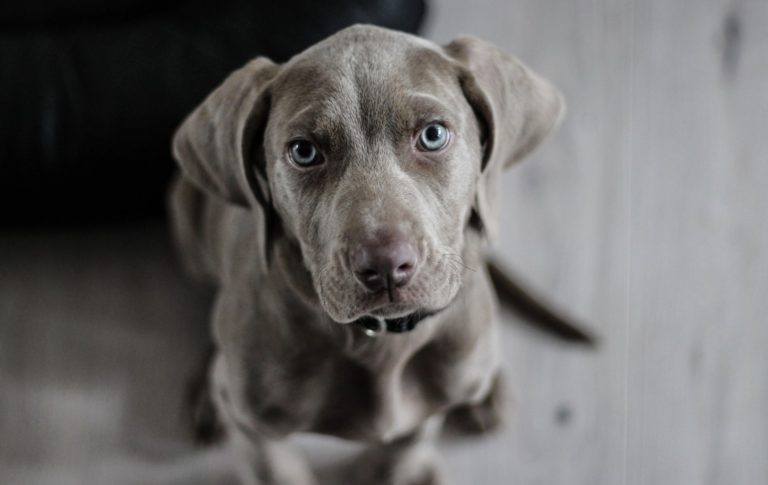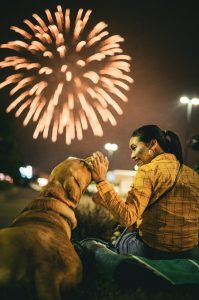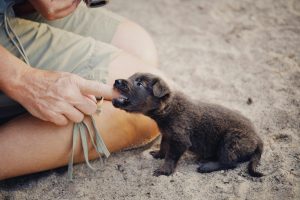Desensitization is a powerful tool you should add to your training sessions. Progressive desensitization is classical conditioning but different. Why? Because with classical conditioning we associate a thing our puppy does with something pleasant. With desensitization, we associate something your puppy doesn’t like, but with something pleasant.
And we do it progressively. You are shaping the classical conditioning process. And you can do with everything your puppy doesn’t love. Or is afraid of. Or barks at.
Today, we will talk about how you can use desensitization therapy to shape your puppy.
What is it?
The simplest way to explain the tool is safe exposure therapy to a stimulus at a level or below a threshold. In other words, gradual exposure to a level where fear is likely to be exhibited.
You can use repeated exposure to change your pet’s attitude or emotional response to a specific stimulus.
The difference between counter conditioning and desensitization is that with the former, you refer to changing your pet’s mood through positive pairing. But with the latter, the treatment of fear and anxiety must focus on achieving desired emotional state and desired behavioral response.
Because we do not suggest punishment, desensitization is a much more suitable tool. The use of punishment is contraindicated in most behavior problems with fear and anxiety.
So, with this technique of repeated exposure to a stimulus, you go from an undesirable reaction to a positive response. Your pet becomes less reactive to the same stimulus.
How to implement the desensitization therapy technique
So, how does it work in reality? Well, think of it this way. Instead of your dog showing negative feelings about an experience, you get positive ones. For example, instead of seeing other dogs as scary, your pet sees them as a chance to earn a game or treat. Here is how to start.
Step 1 – Keep your dog below the threshold
The first step you need to make is finding out your dog’s threshold. In other words, when does your puppy react to the said stimulus?
For example, if you want to find out why your dog is nervous around other dogs, you have to find the threshold. Does that happen when another dog is sniffing your puppy? Or when they are approaching?
The trick here is to keep your dog’s emotional response low enough so that it doesn’t affect its behavior. To put it simply, the problem and traumatic experience is not a problem at the time.
Do whatever it takes, and use relaxation strategies to keep your dog calm. Find the level where your dog doesn’t respond negatively to a problem.
Let me give you an example, Milo doesn’t react to a dog until we get face to face with the dog. What I do is I try to shift his focus towards something else as we are passing a puppy he doesn’t like.
Step 2 – Desensitization
Once you find the level at which your dog doesn’t react, you can start with counter conditioning. Gradual exposure will help you here.
Start at a low level of stimulus and shift your dog’s attention toward something positive. Now, this doesn’t have to be with other dogs. Let me give you another example. Let’s say, your dog barks at bicycles passing by.
But he doesn’t start barking until the bicycle is five feet away. Call a friend with a bicycle. And then gradually start at low levels of stimulus and work out to the final all-out event.
Now, moving from one level to the next is tricky. You will know your pooch is ready for the next level when their association with the given level has become positive.
What are the signs? Well, your dog should look to you for the game, treat, and show body language that can be classified as calm and relaxed. Before you increase the challenge and raise the threshold, it must be obvious that your dog has learned the stimulus predicts good things.
Step 3 – Putting it all together
When you reach the final level of exposure, which in the case of the bicycle is, the bicycle passes by your dog without your puppy barking, it is time for the last step.
So, what is that? Well, this is where repetitive exposure comes. Think of it this way. Let me give you a comparison and analogy. You go to a concert by your favorite band. The first time you experience it is out of this world experience. But go to the same concert the second day, and the third day, and it is not the same. Right?
Well, it is the same with your puppy. The specific stimulus causes a reaction. But when exposed again and again to the same traumatic experience, your dog will lower the frequency of showing an adverse reaction.
In other words, your dog will bark at the bicycle passing by the first time. And probably the second time. But by the time the bike passes by 10 times, your dog will ignore it.
Some great examples of desensitization
We talked about things like a bicycle passing by or other dogs approaching your puppy. But let me give you some other examples of desensitization and how you can use it to modify your puppy’s behavior.
- Distance – begin desensitization from a distance and move progressively closer as your dog is calm and relaxed
- Volume – play sound stimuli in different intensities, going from quiet to loud
- Movement and activity – begin with the stimulus standing and then move to walking slowly, jogging, and then running
- Separating stimuli for exposure – thing of fear of vacuum cleaners. In this case, you have to use classical conditioning for the sight of the machine first at decreasing distance, then to the sound, and then to the movement of the machine
- Characteristics – for example, a pet that is fearful of young children. Start with older children first, those that have better manners around a dog, and then move to smaller children that have to be supervised around a puppy
- Familiarity – this applies to pets that are fearful and anxious with strangers. Begin exposure to family members, then to family friends, and then to strangers
- Location – begin in situations where there is minimal anxiety and then move to a situation where the anxiety becomes more intense
Do not flood your dog
Now I cannot stress this enough. You should never force your dog to face its fear head-on. Yes, you cannot avoid things like other dogs and strangers on the street. But you should flood them.
What is flooding? Well, here is a common example and a mistake. You have a puppy with severe anxiety of other dogs. Instead of working to solve the problem, you go to the dog park and throw your puppy in the middle, thinking socialization with a bunch of dogs will help. Sorry to tell you, but it will not help!
Yes, nothing bad might happen in the dog park. But it is not that easy. It is far more likely that in a park with 10 or more dogs, one will cause another traumatic experience to your puppy. And the experience will backfire. Instead of having your puppy more relaxed around puppies, it is now more fearful than ever.
There is no such thing as rapid desensitization.







